Rebuild civilisation on the back of a giant dinosaur in The Wandering Village
This one certainly lives up to the name.
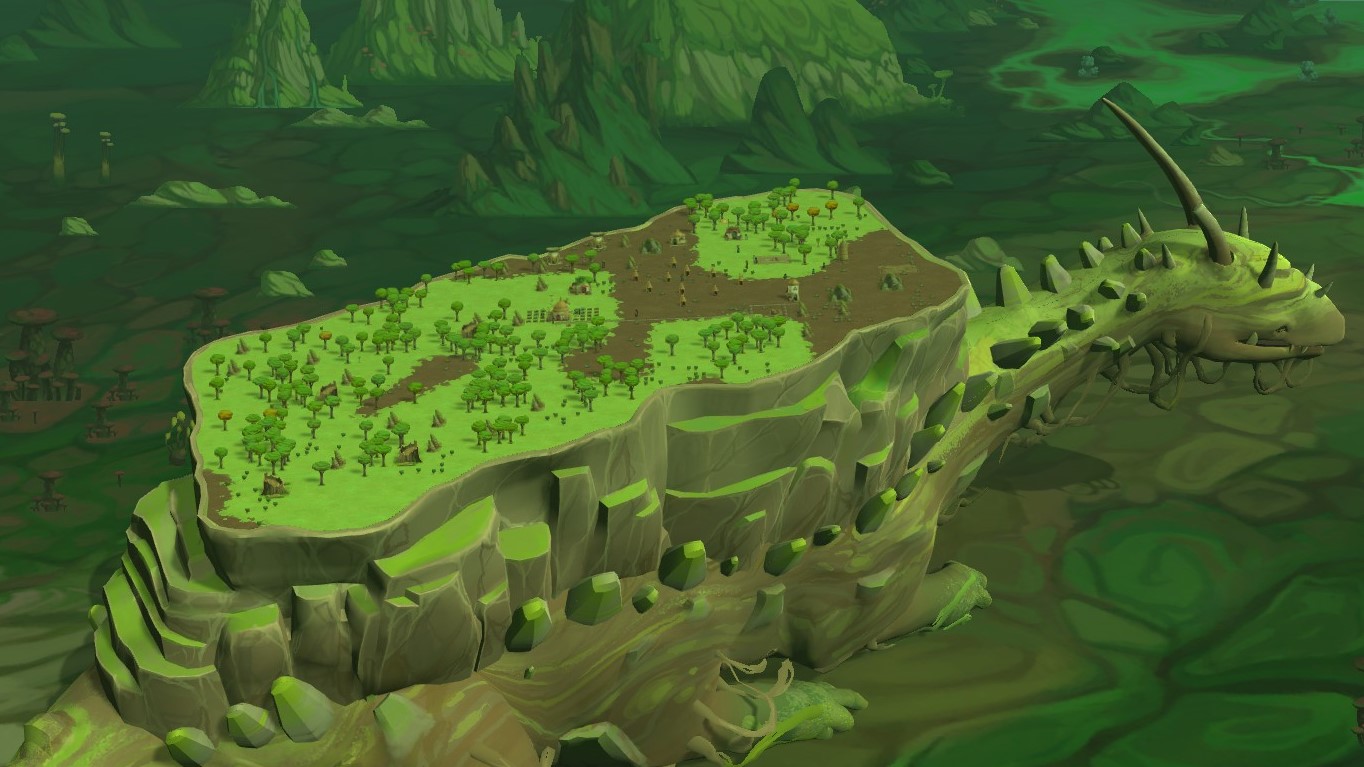
In The Wandering Village you should think of the environment as a living, breathing entity. Mainly because, well, it is. In a world beset by toxic spores that have wiped out civilisation and much of nature, a group of nomads has grasped one last chance by climbing atop an Onbu, a gigantic, six-legged dinosaur-thing with a hard, flat back that sustains its own eco-system.
Up here there’s fertile soil and natural building materials, and by filtering moisture from the air you can even access fresh water. Yet all of this only functions if the Onbu keeps moving: so you’d better make sure it stays alive.
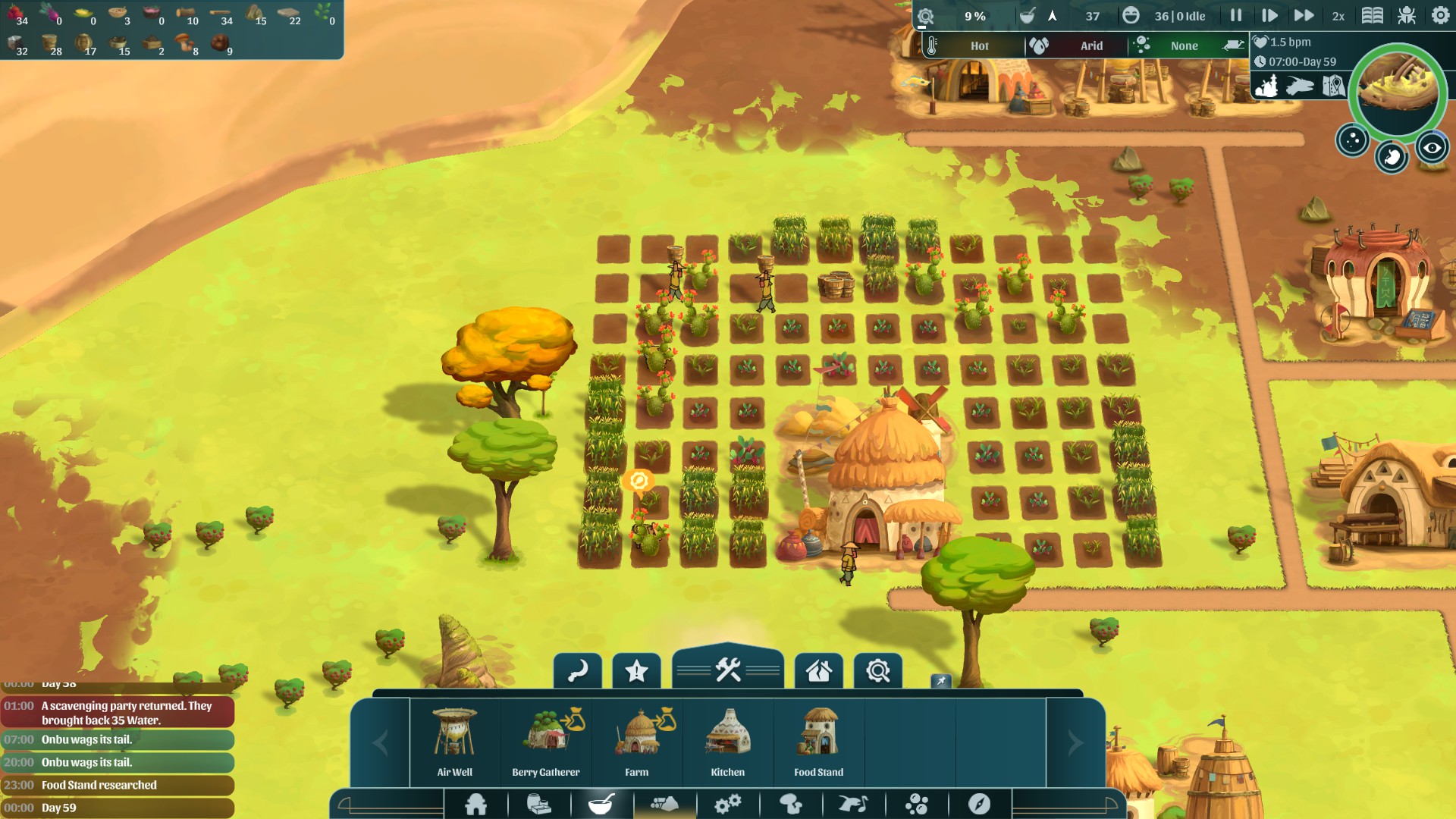
For the opening hours of this early access city builder, however, such concerns take a back seat as you establish your settlement. Food and shelter are pressing concerns, of course, so you have your gang chop trees and smash rocks, then construct tents, a berry gatherer’s hut (berries are the only food that grows naturally on the plateau), a small farm, air wells, storage units, and so on. As the buildings rise, you connect them with strips of dirt road, enabling your eager beaver pioneers to scurry faster, and the basic needs of life start to perpetuate themselves.
So far, so normal for this kind of game, but it functions smoothly, with a tidy interface to help you along. Setting up a farm, for example, is merely a matter of painting an area of cropland around the completed house, adding workers then selecting the kind of produce they should grow (to begin with, the only option is beets, but the roster expands).
Indeed, you don’t direct individual citizens in The Wandering Village. Rather, you assign staff numbers to establishments that are automatically pulled from a pool of ‘general workers’ (harvesters, carriers and builders) as long as you have some to spare. Anyone can do any job if called upon, then, or shuffled back into the manual labour force.
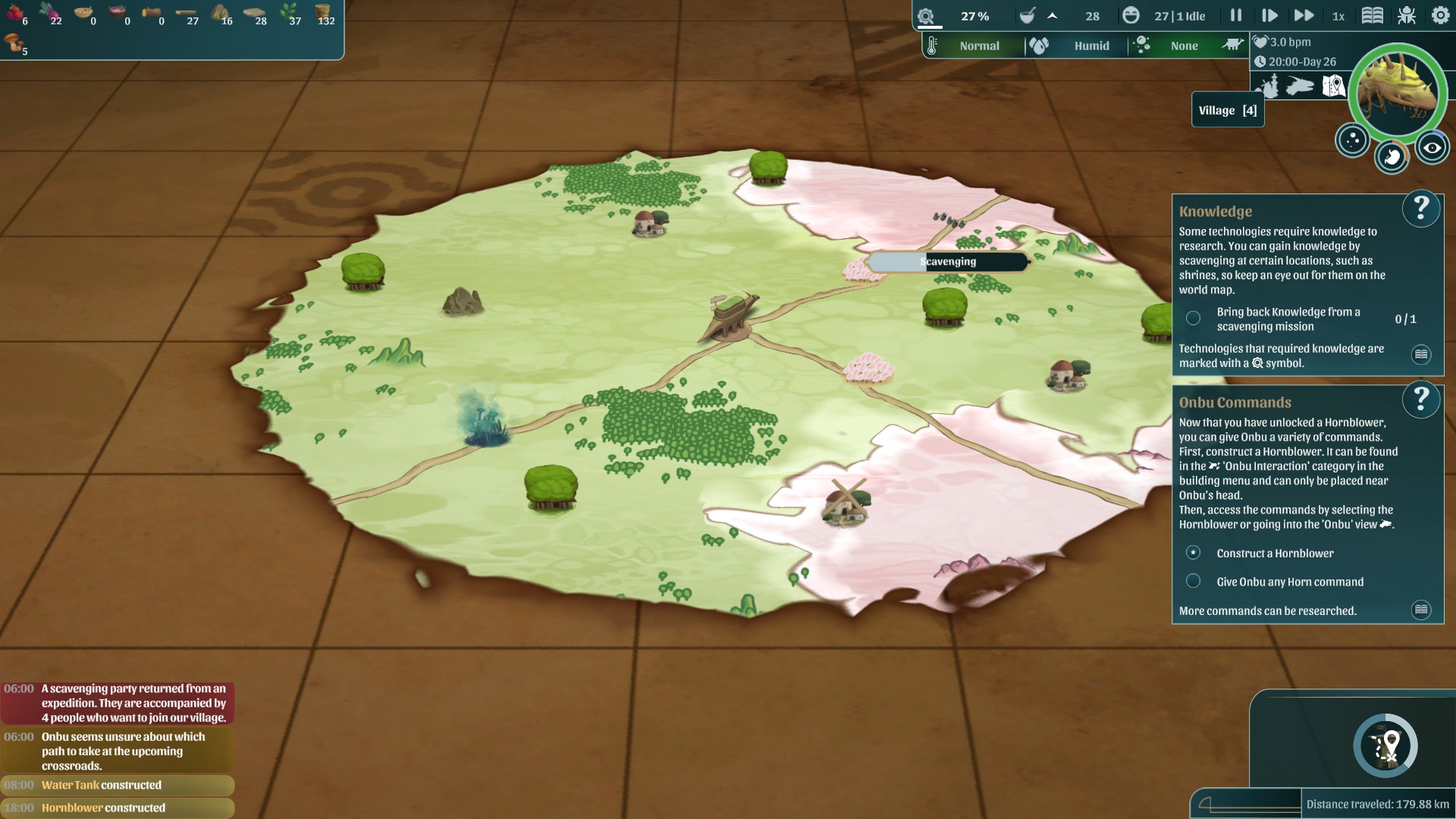
And thanks to the animations of your cartoon charges, it’s a pleasure to zoom-in to the closeup view of your village and watch these transitions and other routines play out. If you allocate an extra kitchen hand, for instance, you may spot one of your general workers returning from the fields to don chef whites. Or simply admire as another gathers fruit or carries logs on their head, or nips off to the pantry to slurp down some beet soup. It’s easy to get caught up in these ordinary lives, until you forget this is all happening on the shoulders of a million-ton herbivore.
Still, you can’t dawdle for long, since you are surrounded by a post-apocalyptic landscape, and because the village is always moving forward, changing climates and weather conditions don’t come to you, you come to them. Passing through spore clouds is one risk, causing nasty growths to form on Onbu that spread poison blight to trees and crops, or infect villagers, until you purge them. Now suddenly there’s a lot to do. You’ll likely need a doctor to cure the sick and a herbalist to grow medicine, and that requires scientific research, which in turn requires knowledge. So you’ll need a scavenger’s hut from which you can send expeditions into the world, bringing back more materials, additional nomads or ancient expertise that’s essential for technological advancement.
The biggest gaming news, reviews and hardware deals
Keep up to date with the most important stories and the best deals, as picked by the PC Gamer team.
Environmental concerns
Meanwhile, different biome types (there are three at the moment, with more due) affect how crops grow. Enter a desert, say, and you can only collect water by growing cactus on your farm, and you’d better assemble a second farm to grow heat-resistant corn. More building, more research. From there, increasingly, much of your work comes down to strategically opening and closing various workplaces. Perhaps a patch of poison is spreading: so you shut your quarry for a while, stopping stone production, or swap doctors for more farm workers, since nobody’s ill, at least not right now.
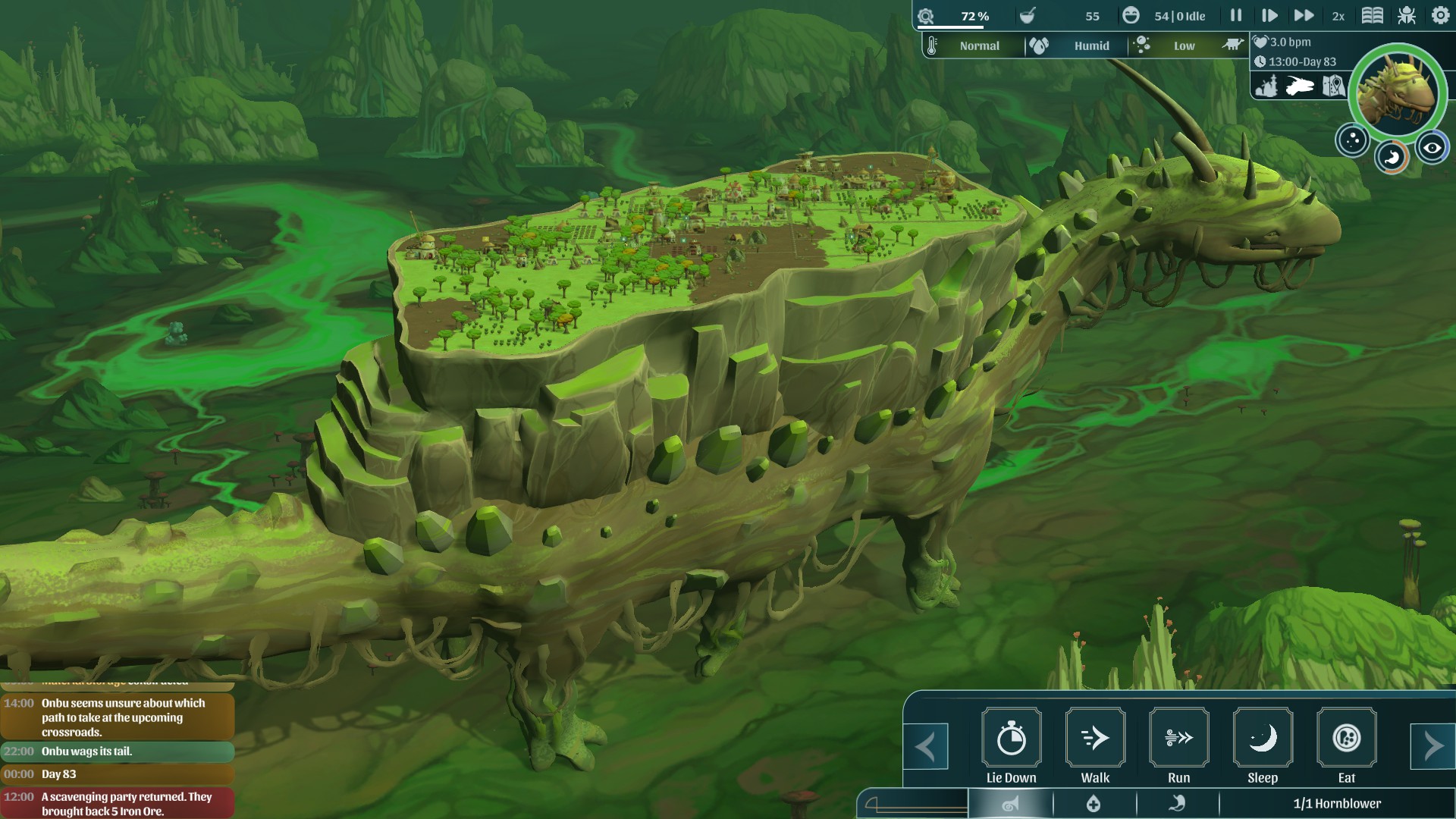
As engaging as these travails are, though, the real 'X' factor in The Wandering Village is Onbu itself, a majestic beast indeed, and as it lumbers mile after mile you need to pay it more attention. Onbu’s status is measured by toxicity levels, hunger, tiredness and overall health, and as long as it can find food and uncontaminated areas to sleep, it largely takes care of itself. Eventually though, you’ll grow mushrooms that can be mashed into pellets then launched towards the beast’s maw, plus install an Onbu doctor, and a great horn through which you can communicate basic commands: telling it to run through poisonous areas, for example, or go north rather than south at a fork in the path.
Without you, in fact, the behemoth would eventually walk to its own death, and you can’t but form a bond with it as it splits your attentions. Yet as conditions worsen, you’re also given options to exploit the creature’s anatomy to make life easier. Collecting its dung for fertiliser is innocent enough, but what about extracting its bile to use as fuel, or drilling into its back for rock supplies?
Choose such paths and the penalty is erosion of trust, causing Onbu to ignore your commands. But it’s your decision how much your relationship shifts from symbiotic towards parasitic. It’s apt, perhaps, that zooming out from the village, your people do look a little like teeming, biting insects.
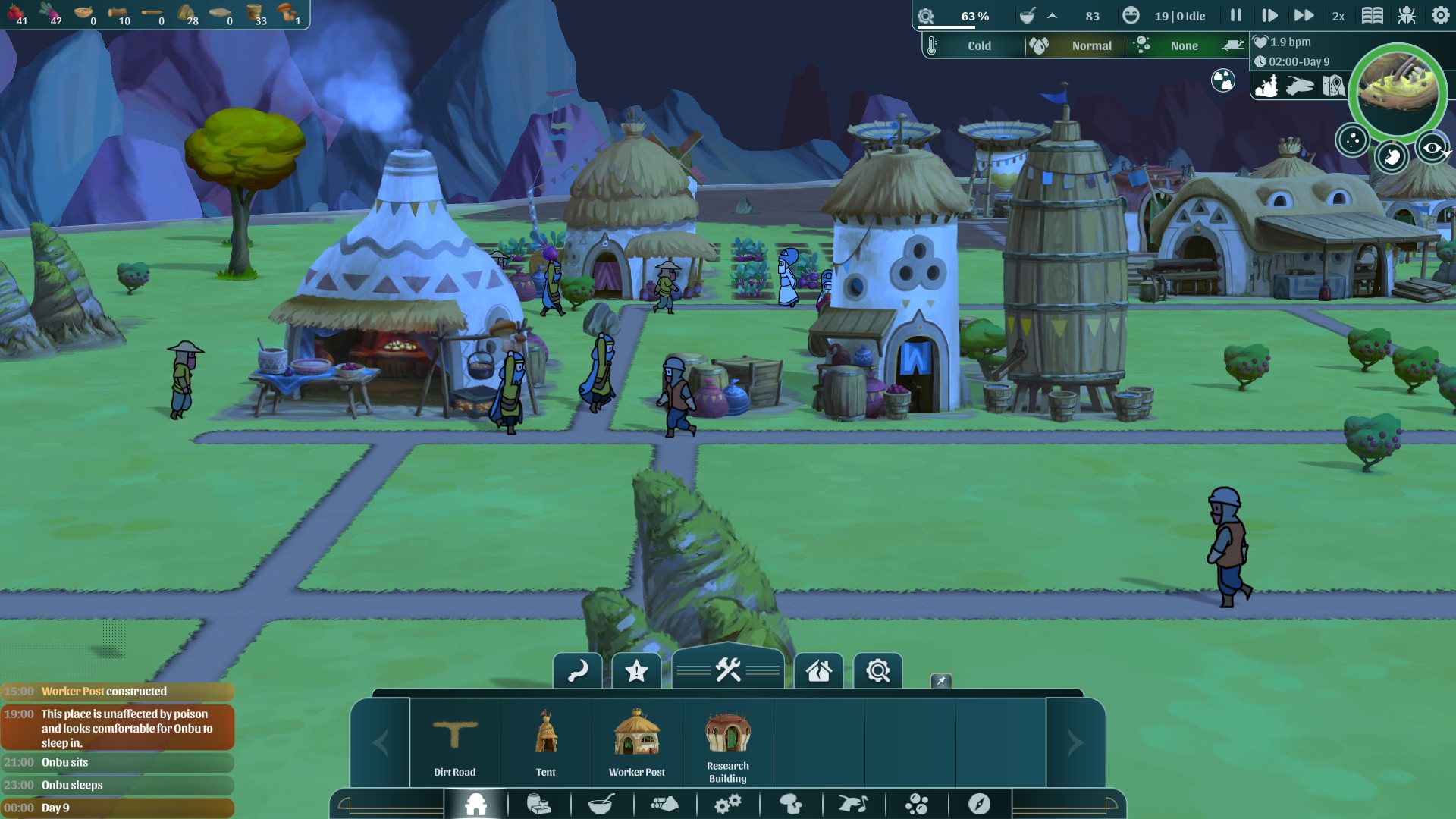
Currently, however, it has to be said that these decisions aren’t quite the sticky dilemmas they could be. On the medium difficulty setting, I managed to reach the game’s current ending (although you can continue indefinitely) without being tempted into vampiric pursuits, and only saw the game over screen once. More broadly, few events have dramatic consequences as things stand, and villagers are almost too efficient and easily pleased: you don't have to work that hard to keep them happy. While there are plenty of features in place, then, another layer of depth and friction will be crucial in the long run.
Still, The Wandering Village has strong foundations: even at this stage it’s hard to pick fault beyond the lack of challenge. My only complaints are that the notification system isn’t prominent enough, poison plants sometimes get obscured behind other scenery, and mouse wheel camera zoom stopped working a few times, but that’s all. Like the workers in the village, the systems are already pulling in the same direction.
And that’s the beauty of The Wandering Village’s thinking, even when it isn’t the most intense experience. Everyone works towards a common goal that takes into account the continuing health of the land on which it depends. Despite the toxic spores and hard work, this is a kind of mini-Utopia, devoid of rigid hierarchies, jealousy and greed. Living on Onbu feels like a privilege, so maybe it’s the city builder we need right now.

